WASHINGTON ― As the U.S. Congress hardens against Beijing, two key lawmakers publicly added their support for a new military fund to boost deterrence against China in the Pacific, virtually assuring a Pacific Deterrence Initiative of some kind will be in the next defense policy bill.
Senate Armed Services Committee Chairman Jim Inhofe, R-Okla., and ranking member Jack Reed, D-R.I., announced their new stance in a War on the Rocks op-ed Thursday. They said their version will back investments in land-based, long-range strike capabilities, but also “theater missile defense, expeditionary airfield and port infrastructure, [and] fuel and munitions storage,” to enable new modernized platforms, rather than buying more of the platforms themselves.
“With the stakes so high, the time for action is now,” Inhofe and Reed wrote. “The Pacific Deterrence Initiative will enhance budgetary transparency and oversight, and focus resources on key military capabilities to deter China. The initiative will also reassure U.S. allies and partners, and send a strong signal to the Chinese Communist Party that the American people are committed to defending U.S. interests in the Indo-Pacific.
“The Pacific Deterrence Initiative will focus resources on these efforts and others with the aim of injecting uncertainty and risk into Beijing’s calculus, leaving just one conclusion: ‘Not today. You, militarily, cannot win it, so don’t even try it.’”
The Senate leaders follow House Armed Services Committee Chairman Adam Smith, D-Wash., and ranking member Mac Thornberry, R-Texas, in supporting the idea of a PDI. Smith has backed the idea in concept but has not publicly disclosed his priorities for the fund, while Thornberry has proposed spending $6 billion in fiscal year 2021 on priorities that include air and missile defense systems and new military construction in partner countries.
As Congress looks to replicate the multi-year European Deterrence Initiative — which consumed $22 billion since its inception after Russia invaded Ukraine and illegally annexed Crimea in 2014 — it has yet to be negotiated how much could be spent in the Pacific, what it would buy there and how long the fund would endure. Those questions will likely be part of talks within the Armed Services and Appropriations committees.
“I expect to see some new money applied to these priorities in the budget,” said Center for New American Security analyst Eric Sayers, who has advocated for the fund. “The real challenge now will be convincing the appropriators to join them and then the Pentagon building it into their 2022 budget.”
Speaking in the afternoon at a Center for Strategic and Budgetary Assessments event, Heino Klinck, deputy assistant secretary of defense for East Asia, said that he personally thinks the idea of a PDI is one that will work.
“Obviously when the National Defense Strategy came out, it very clearly stated that the priority theater is, for us, the Indo-Pacific,” Klinck said. “But all of us also recognize that strategy is budget, and budget is strategy, and the budget numbers have not supported, to date, the Indo-Pacific’s role as the primary theater.”

Though Defense Secretary Mark Esper has said China tops DoD’s adversaries list, the Pacific spending proposals reflect some frustration within the Armed Services Committees that the Pentagon has not prioritized the region in line with the National Defense Strategy’s emphasis on great power competition. Inhofe and Reed’s op-ed criticized the Pentagon’s emphasis on platforms when they argue it should be emphasizing missions and the force posture, capabilities and logistics that would enable those missions.
To that end, Inhofe and Reed are seeking funding in categories similar to the EDI: Military construction, fuel and munitions storage and deployable air-base kits. That is to say, runways and fuel depots a war plane might need, but not extra planes.
“It doesn’t matter how many F-35s the military buys if very few are stationed in the region, their primary bases have little defense against Chinese missiles, they don’t have secondary airfields to operate from, they can’t access prepositioned stocks of fuel and munitions, or they can’t be repaired in theater and get back in the fight when it counts,” Reed and Inhofe wrote.
Whatever final shape the fund takes will likely draw from a landmark report Congress required from Indo-Pacific Command, delivered to Congress in early April. That report, penned by the command’s chief, Adm. Phil Davidson, called for $1.6 billion in funding in FY21 and an additional $18.46 billion over FY22-FY26.
That funding was broken into five categories: Joint force lethality, force design and posture, strengthen allies and partners, exercises, experimentation and innovation, and logistics and security enablers. It included a 360-degree persistent and integrated air defense capability in Guam, for $1.67 billion cost over six years, new radars and the development of small bases around the Pacific to break up large targets for Chinese weapons.
Thornberry’s plan featured similar categories, but increased the near-term funding request dramatically. One congressional staffer said that Thornberry, who is retiring come January, has been realistic that the whole $6 billion request is unlikely to survive the coming budget fights. The goal, the staffer said, is to get something through that creates the account, in hopes it can grow moving forward.
Smith hasn’t made his own proposal, but his spokesperson said last month that he favors an account to “responsibly fund activities that are fully supported by DoD, avoid budgetary gimmicks, and require DoD to provide additional information to ensure DoD is strategically aligning resources toward the challenges and objectives in the Indo-Pacific."
Joe Gould was the senior Pentagon reporter for Defense News, covering the intersection of national security policy, politics and the defense industry. He had previously served as Congress reporter.
Aaron Mehta was deputy editor and senior Pentagon correspondent for Defense News, covering policy, strategy and acquisition at the highest levels of the Defense Department and its international partners.





